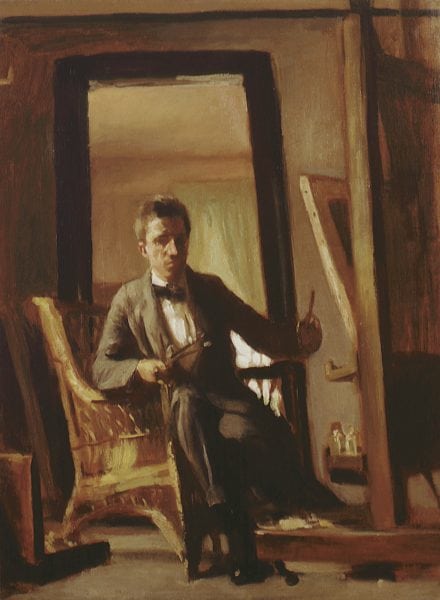Artist at Easel (Self-Portrait), ca. 1921-1923
Guy Pene du BoisOil on canvas
25 3⁄8 × 19 inches
Provenance
Kraushaar Galleries, New York
Private Collection
Multi-faceted Guy Pène du Bois, known as a painter, critic, and teacher, was associated with the progressive realist movement that coalesced in the beginning of the twentieth century. His early career was significantly influenced by Robert Henri, who served as a mentor to Pène du Bois and with whom he studied from 1902-1905. Like Henri, his art emphasized figurative themes, though he later developed a uniquely satirical edge. Pène du Bois followed many of the essential tenets advocated by Henri, which included painting from life directly onto the canvas (without underdrawing), use of darkened, somber tonalities and broad, expressive brushwork.[1] These qualities are all manifested in this rare self-portrait by Pène du Bois, Artist at Easel. This painting has been ascribed to ca. 1921-23, a period in which the artist was transitioning toward his streamlined, lighter, and more colorful mature style.[2]
The composition is exceptional within Pène du Bois’ oeuvre. Only two other painted self-portraits by Pène du Bois have been identified, and they are included within major paintings: The Beach (1924; Sheldon Memorial Art Gallery, University of Nebraska) and Bal des Quartres Arts (1929, Smart Gallery, University of Chicago). In these two works, however, his presence is not central to the compositions, but is integrated within a complex narrative of multiple figures. Artist at Easel (Self-Portrait) is also distinguished by the fully-realized and defined nature of the interior space, likely his own studio, in which he depicts himself. As Pène du Bois’ style crystallized, he later tended to generalize and increasingly minimize background environments and visual details.
The theme of the painting may also reveal a psychological underpinning. Periodically, Pène du Bois became weary of writing art criticism, which along with teaching provided him with regular income. In 1921, he left his writing position at Arts & Decoration and turned to defining his reputation as a painter. In this uncommon endeavor, he chooses to depict himself in the act of painting, picturing himself in the role of an artist.
“The composition was most likely taken from a reflection in the mirror. Though dark in overall tonalities, the painting exhibits strong contrasts seen in the light emanating from the window and the reflections in the artist’s white shirt. Painted in a stylistic manner that recalls the early portraits of Robert Henri, as well as those by Pène du Bois’ close contemporaries, William Glackens and Edward Hopper, who initially worked in similarly dark palettes and used strong contrasts, Pène du Bois’ composition is however distinguished by the overall conception of the composition. In this notable self-portrait, the artist pictures himself dressed in a formal manner, sitting and engaged in painting a canvas tilted toward him. Executed just before Pène du Bois departed for an extended stay in France, which heralded a new phase in his career as a painter, this work combines a distinctly American stylistic sensibility with aspects of the European tradition of the artist self-portrait, seen in works by Daumier, Van der Weyden, and Velazquez.”
Valerie Ann Leeds, Ph.D.
19 September 2003
[1] See Elizabeth Lee Fahlman, “Guy Pène du Bois Painter, Critic, Teacher,” (Ph.D dissertation, University of Delaware, 1981) for a thorough treatment of the artist’s art, life, and career. For Henri’s stylistic influence, see pp. 16-18. See also, for example, H. Alexander Rich, “Artist or Critic? Guy Pène du Bois and the Search for Artistic Identity,” (Ph.D dissertation, Institute of Fine Arts, New York University, 2013) and Betsy Fahlman, Guy Pène du Bois: Painter of Modern Life, (New York, 2004).
[2] Betsy Fahlman to Daniel Barr (September 2, 2001), Gerald Peters Gallery archive.
Exhibited
- New York, Gerald Peters Gallery, The Figure: From Cubism to Post Modern, June 14-August 17, 2007.
- Greenwich, Connecticut, Greenwich Historical Society, A Good Light: The Artist’s Studion in Cos Cob and Beyond, October 2, 2012-January 6, 2013.

